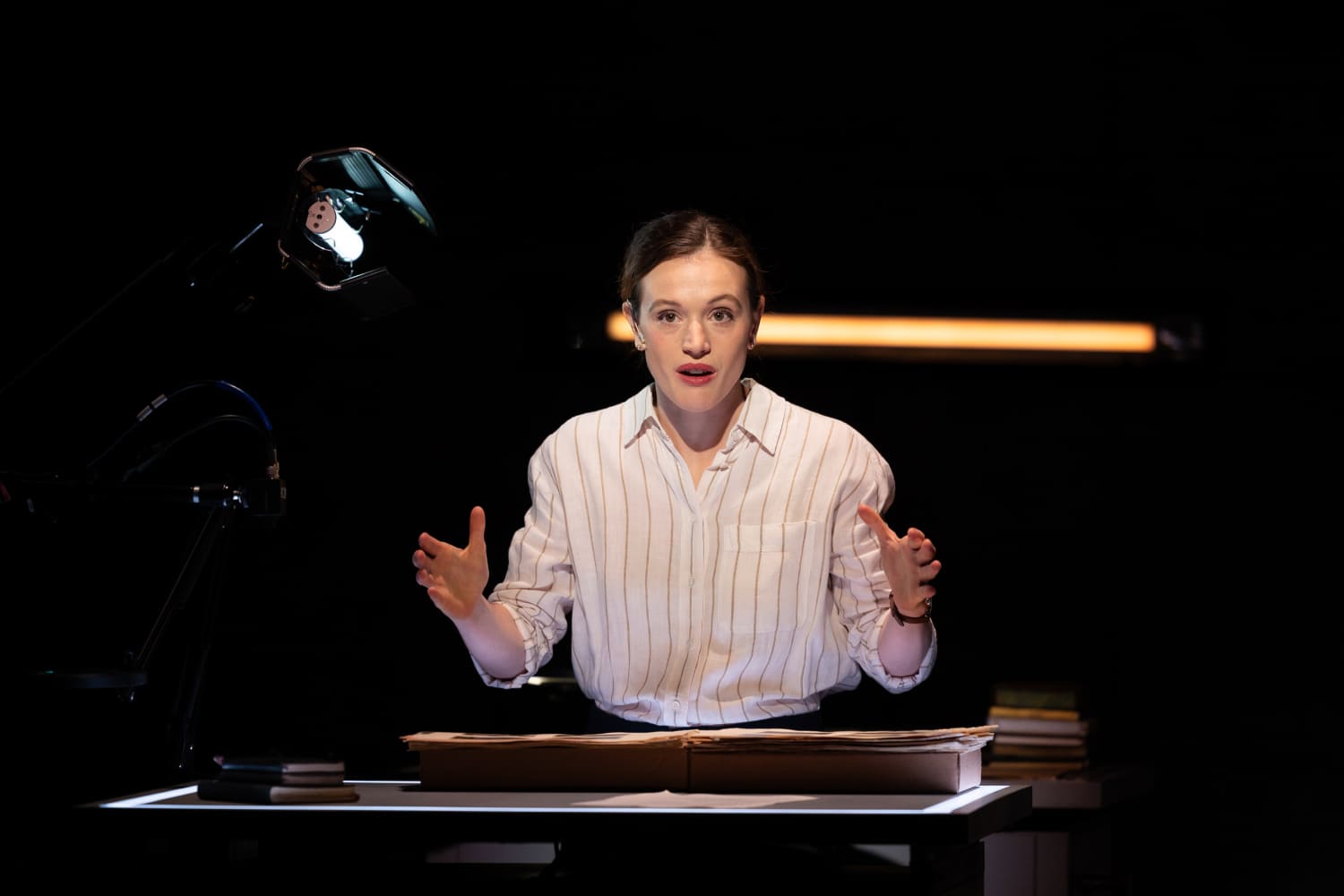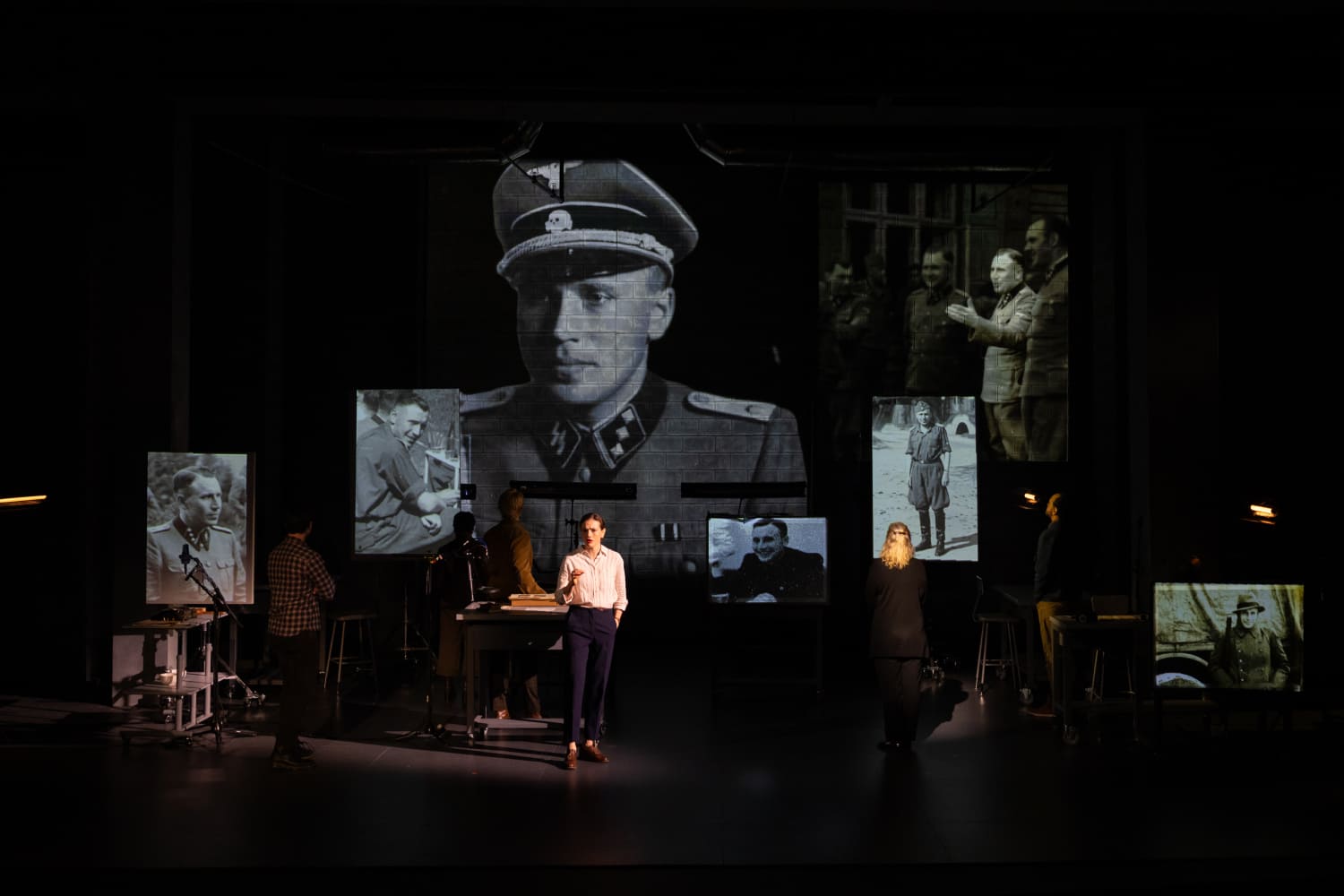
Marrick Smith and Folami Williams in "Here There Are Blueberries." (Photo by Morgan Sophia Photography)
One man made candy. Another was an accountant. Yet another was a bank teller - a family man with a wife and children. But together, these men helped operate the “largest human killing center in all of history.”
While many plays about the Holocaust and other tragedies focus on the victims, the Pulitzer Prize finalist "Here There Are Blueberries," based on real events, centers largely on the perpetrators. To their credit, co-writers Moisés Kaufman and Amanda Gronich don’t glorify them. Instead, by presenting these offenders as ordinary humans rather than monsters, the eye-opening Here There Are Blueberries reminds us that any one of us can commit evil acts.
A Homecoming for Miami New Drama
The shocking play from Tectonic Theater Project - as gripping as a John Grisham page-turner - is receiving a riveting professional production by Miami New Drama (MIND) through Dec. 7 at the company’s home, the Colony Theater in Miami Beach. Under Kaufman’s precise, sensitive direction, a cast of talented actors naturalistically portray everyone from archivists at the United States Holocaust Memorial Museum in Washington, D.C., to the descendants of Holocaust perpetrators.
MIND’s mounting of "Here There Are Blueberries" is something of a homecoming for the award-winning nonprofit company. Several years ago, Kaufman - a MIND co-founder and the founder/artistic director of Tectonic Theater Project - told MIND artistic director and co-founder Michel Hausmann about an idea sparked by a newly discovered photo album belonging to Nazi officials at Auschwitz. Hausmann expressed interest, so Kaufman and Gronich came to Miami to develop the piece, which was included in MIND’s 2017–2018 season as a work-in-progress titled "The Album."
Since that early presentation, the play - eventually titled "Here There Are Blueberries" - premiered professionally in 2022 at La Jolla Playhouse, followed by a 2023 production at the Shakespeare Theatre Company in Washington, D.C. It then had its Off-Broadway premiere in 2024 before embarking on national and international tours.
Before coming full circle back to MIND, the play won the 2025 Lucille Lortel Award for Outstanding Play and two Helen Hayes Awards. It was also a 2024 Pulitzer Prize finalist, recognized by The Wall Street Journal as one of the “10 Best Plays of 2024,” and received the 2022 Theater J Trish Vradenburg Jewish Play Prize.

Delia Cunningham as Rebecca Erbelding is at the center of "Here There Are Blueberries" at Miami New Drama. (Photo by Morgan Sophia Photography)
The Meaning Behind the Title
The play’s title refers to an unsettling image in a Nazi photo album: officers at Auschwitz smiling, relaxing, and enjoying themselves while mass murder took place nearby. The album eventually reached staff members at the Holocaust museum in Washington, D.C.
In the image from which the play takes its title, Auschwitz officers hand out bowls of blueberries to young women who worked with the SS in various capacities. The women enjoy their blueberries while, just out of frame, mass murder unfolds. That chilling juxtaposition - pleasure existing alongside atrocity - encapsulates the disturbing moral contradiction at the heart of the play.
In their script, the authors state that theater companies must present the play with dialogue and images; the show cannot exist without both. MIND honors their request. David Bengali’s projections are consistently clear and vivid.
Craft and Power
It’s no wonder "Here There Are Blueberries" has earned so many honors. The piece is tightly written (about 90 minutes without intermission), humanizes the people we meet - again, without glorifying perpetrators - and avoids melodrama. Its power also lies in showing how the past lingers within families, and how confronting it can break cycles of silence.
Kaufman and Gronich include many memorable, haunting quotes. They will likely stay with you long after the play ends. One of the most powerful comes from the grandson of Rudolf Hoss, the Nazi SS commander of Auschwitz: “I am the grandson of a mass murderer. I can’t change that. But I am who I choose to be.”
Another striking quote comes from Pawel Sawicki, Auschwitz-Birkenau State Museum Press Officer: “Sometimes when people look at the world of Auschwitz, they focus on the killing and they forget that the killing is the result of a long process. No genocide starts with killing. Every genocide starts with words.”
After hearing such lines, we may reconsider the language we use with family members, friends, strangers, and even those with whom we disagree. Does our language bring people closer, or does it alienate? Does it inflame conflict or help diffuse it? We do not have to search far in history for examples of rhetoric fueling violence.

Delia Cunningham and the cast of "Here There Are Blueberries." (Photo by Morgan Sophia Photography)
Anchoring History
Speaking of history, "Here There Are Blueberries" presents it without lecturing or preaching. Instead, the play immediately situates us inside an institution devoted to preserving the past. At the top of the play, we are at the United States Holocaust Memorial Museum in Washington, D.C., in 2007 (although the production could be clearer about the timeframe). Even before the action begins, we enter the theater to find a camera onstage pointed directly at us. That seems intentional on Kaufman’s part - perhaps inviting us to consider our own role in shaping world events, including atrocities.
Though the play is solemn, it does not plunge us immediately into darkness. Instead, it eases into its grim subject matter with narration about the development and widespread use of cameras during the 1930s and beyond. Without cameras, after all, we would lack much of the visual evidence that anchors the story.
Early on, an accordion player performs lively, upbeat music - fitting for the lighter opening section. But as the subject matter darkens, the soundscape deepens the unease. A slow, loud gate opening is ominous. Gunshot-like bangs punctuate the rapid appearance of photographs on a projection screen, underscoring their weight. Another effective sound element (designed by Bobby McElver) is the ticking of a clock, symbolizing the urgency of the story and the shrinking window in which survivors can speak. Indeed, the population of Holocaust survivors is rapidly declining. About 70 percent are projected to die within the next 10 years, and 90 percent within 15 years. The median age is around 87.

Delia Cunningham and the cast of "Here There Are Blueberries." (Photo by Morgan Sophia Photography)
Giving Victims the Final Word
While "Here There Are Blueberries" focuses mostly on architects of the Holocaust, a moving section near the end features a survivor discovering an album containing images of her family. Kaufman and Gronich wisely place this true story at the conclusion. Opening the play with the survivor could have shifted the focus too heavily and left us with less mental and emotional room to consider the perpetrators’ humanity. Ending with the survivor gives victims the final word.
Humanity Among the Staff
The play also humanizes the museum staff. At one point, Rebecca Erbelding’s boss, Judy Cohen, says: “When I first got to the museum, I had a horrible time sleeping.” Rebecca replies, “And now? How do you do it?” Judy answers: “I put blinders on and I focus on the details. Was this June or was this July, who’s in the photograph, what time of day is it? And I say: make sure you get the facts right. Because I can’t think of the horror day in and day out, or I’ll never be able to do my job.”
We might wish to know more about Rebecca and Judy’s backgrounds - for example, why they chose to work at the museum. Do they have relatives who survived the Holocaust? Still, the quotes above strongly ground their humanity.

Delia Cunningham, Grant Varjas, Folami Williams, Jonathan Raviv, and Christian Pedersen. (Photo by Morgan Sophia Photography)
Nuanced Performances
The performers deliver touching, nuanced portrayals of real people. Delia Cunningham plays Rebecca Erbelding, an archivist, curator, and historian at the museum, with believable sincerity and determination. Her gestures are unforced, and her tone conveys seriousness; at one point, she places her hands on her heart, reinforcing her character’s earnestness.
Barb Pitts McAdams portrays Judy Cohen as a wise, grounded leader - serious and businesslike without being cold. When Cohen asks Erbelding how she is holding up, McAdams makes the concern feel fully genuine.
Marrick Smith sensitively portrays Rainer Hoss, grandson of Rudolf Hoss. Initially, Smith’s Hoss is guarded when approached about his grandfather’s role in the Holocaust, but gradually - almost imperceptibly - he opens up.
The man who approaches him is Tilman Taube, whose grandfather, Dr. Heinz Baumkötter, was head physician at the Sachsenhausen concentration camp. During the play, Taube commits himself to tracking down Hoss and other descendants of Nazi officials. Jonathan Raviv brings convincing gravitas and passion to Taube, rendering him determined without slipping into overbearing intensity.
While the performances are uniformly strong, actors portraying characters from Germany sound too American. And one sound effect, the clinking of utensils during the Blueberry photo sequence, seems unnecessary. But overall, it’s hard to find fault with the choices made.
Design Elements
The actors perform on Derek McLane’s minimalist yet spacious set. It’s functional without calling too much attention to itself, allowing the focus to remain on the story and characters.
David Lander’s lighting is mostly dim. While the designer clearly illuminates performers during action, the stage is mostly dark, which befits this serious play. In addition, the dim lighting allows us to clearly see the images.
Similarly, Dede Ayite’s costumes are mostly dark, creating consistency between the design elements.

The cast of "Here There Are Blueberries." (Photo by Morgan Sophia Photography)
Education and Legacy
It was encouraging to hear that teachers attended the performance I saw. Education, after all, will be critical to keeping Holocaust survivors’ harrowing stories alive in the public consciousness as their numbers continue to diminish. And powerful, unflinching works such as Here There Are Blueberries play an essential role in that effort. By bringing a shameful past into vivid focus and refusing to ignore its contradictions, the play helps ensure we do not forget - and that we remain alert to how history can echo into the present.
WHAT: Miami New Drama’s professional production of the gripping and relevant play, Here There Are Blueberries.
WHEN: Through Dec. 7.
WHERE: Colony Theatre, 1040 Lincoln Road in Miami Beach.
TICKETS: Call (305) 674-1040 or visit https://miaminewdrama.org.




